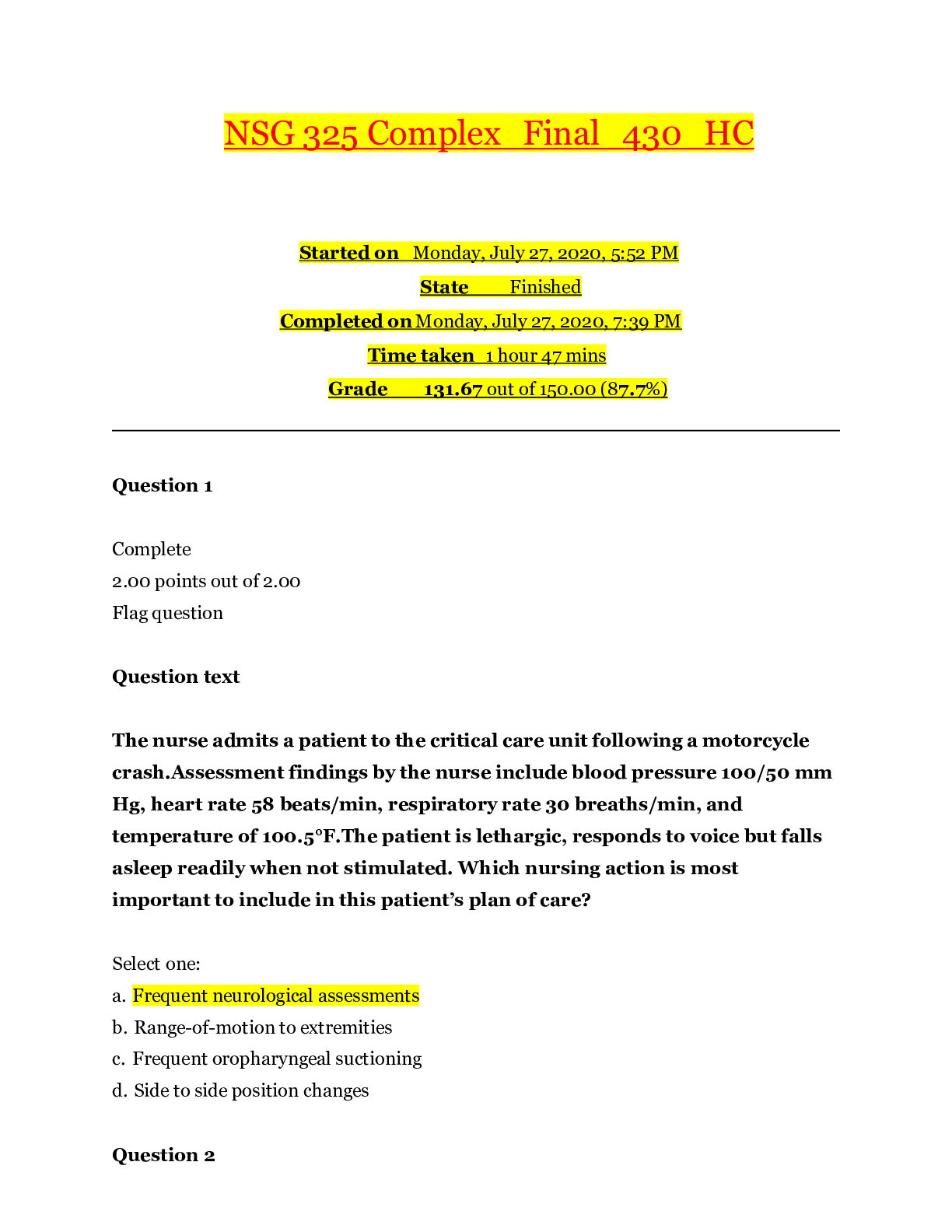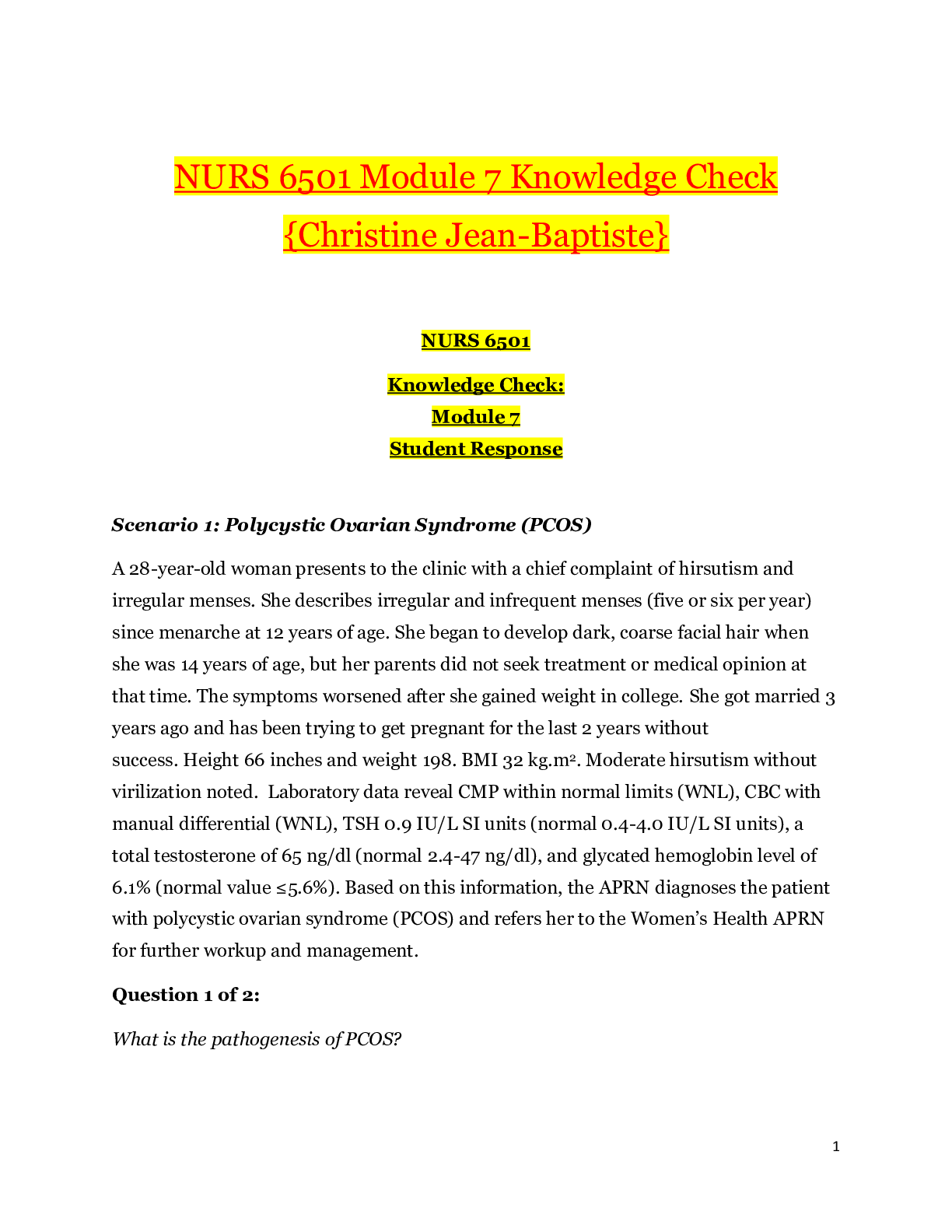NSG 325 Complex_Final_430_HC _2020 | NSG325 Complex_Final_430_HC _Gaded A
Document Content and Description Below
NSG 325 Complex_Final_430_HC Started on Monday, July 27, 2020, 5:52 PM State Finished Completed on Monday, July 27, 2020, 7:39 PM Time taken 1 hour 47 mins Grade 131.67 out of 150.00 (87.7%) ... Question 1 Complete 2.00 points out of 2.00 Flag question Question text The nurse admits a patient to the critical care unit following a motorcycle crash. Assessment findings by the nurse include blood pressure 100/50 mm Hg, heart rate 58 beats/min, respiratory rate 30 breaths/min, and temperature of 100.5°F. The patient is lethargic, responds to voice but falls asleep readily when not stimulated. Which nursing action is most important to include in this patient’s plan of care? Select one: a. Frequent neurological assessments b. Range-of-motion to extremities c. Frequent oropharyngeal suctioning d. Side to side position changes Question 2 Complete 2.00 points out of 2.00 Flag question Question text The nurse is caring for a burn-injured patient who weighs 154 pounds, and the burn injury covers 40% of his body surface area. The nurse calculates the fluid needs for the first 24 hours after a burn injury using a standard fluid resuscitation formula of 4 mL/kg/% burn of intravenous (IV) fluid for the first 24 hours. The nurse plans to administer what amount of fluid in the first 24 hours? Select one: a. 2800 ml b. 14000 ml c. 11200 ml d. 7000 ml Question 3 Complete 0.00 points out of 2.00 Flag question Question text For patients with major burns, when should you start enteral feedings? Select one: a. A few hours after the injury has occurred b. Not until bowel sounds have returned c. 2 to 3 days after the injury d. After the emergent phase of the injury Question 4 Complete 2.00 points out of 2.00 Flag question Question text After receiving the handoff report from the day shift charge nurse, which patient should the evening charge nurse assess first? Select one: a. A patient with bacterial meningitis on droplet precautions b. Mechanically ventilated patient with a GCS of 6 c. Patient with meningitis complaining of photophobia d. A patient with an intracranial pressure ICP of 20 mm Hg and an oral temperature of 104°F Question 5 Complete 2.00 points out of 2.00 Flag question Question text The charge nurse assigns patients based on their acuity and the level of experience of the critical care nurses on duty. This is an example of implementation of: Select one: a. National patient safety goals b. Healthy work environment c. SBAR communication d. Synergy model Question 6 Complete 2.00 points out of 2.00 Flag question Question text While caring for a patient with a basilar skull fracture, the nurse assesses clear drainage from the patient’s left naris. What is the best nursing action? Select one: a. Place a nasal drip pad under the nose. b. Have the patient blow the nose until clear. c. Suction the left nares until the drainage clears. d. Insert bilateral cotton nasal packing. Question 7 Complete 2.00 points out of 2.00 Flag question Question text The nurse is caring for a patient who was hit on the head with a hammer. The patient was unconscious at the scene briefly but is now conscious upon arrival at the emergency department with a GCS score of 15. One hour later, the nurse assesses a GCS score of 3. What is the priority nursing action? Select one: a. stimulate the patient hourly. b. Continue to monitor the patient. c. Elevate the head of the bed. d. Notify the provider immediately. Question 8 Complete 0.00 points out of 2.00 Flag question Question text The nurse is caring for a patient who has a diminished level of consciousness and who is mechanically ventilated. While performing endotracheal suctioning, the patient’s hands clench and pull into the chest. What is the best interpretation by the nurse? Select one: a. The patient is exhibiting decorticate posturing. b. The patient is exhibiting extension posturing. c. The patient is exhibiting flexion posturing. d. The patient is exhibiting purposeful movement. Question 9 Complete 2.00 points out of 2.00 Flag question Question text Which of the following would be seen in a patient with myxedema coma? Select one: a. Hyperthermia b. Tachycardia c. Hyperventilation d. Decreased reflexes - -- - - - -- - - Continued [Show More]
Last updated: 2 years ago
Preview 1 out of 66 pages

Buy this document to get the full access instantly
Instant Download Access after purchase
Buy NowInstant download
We Accept:

Reviews( 0 )
$14.00
Can't find what you want? Try our AI powered Search
Document information
Connected school, study & course
About the document
Uploaded On
Mar 17, 2021
Number of pages
66
Written in
Additional information
This document has been written for:
Uploaded
Mar 17, 2021
Downloads
0
Views
50

.png)












